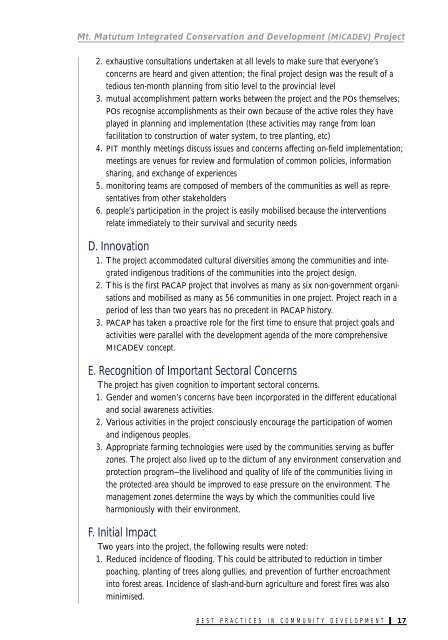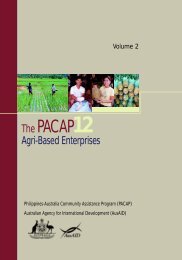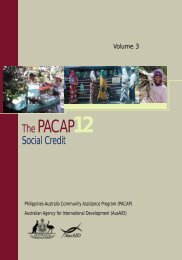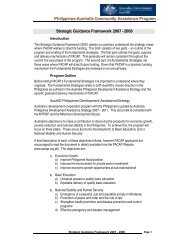The PACAP12
The PACAP12
The PACAP12
You also want an ePaper? Increase the reach of your titles
YUMPU automatically turns print PDFs into web optimized ePapers that Google loves.
Mt. Matutum Integrated Conservation and Development (MICADEV) Project<br />
2. exhaustive consultations undertaken at all levels to make sure that everyone’s<br />
concerns are heard and given attention; the final project design was the result of a<br />
tedious ten-month planning from sitio level to the provincial level<br />
3. mutual accomplishment pattern works between the project and the POs themselves;<br />
POs recognise accomplishments as their own because of the active roles they have<br />
played in planning and implementation (these activities may range from loan<br />
facilitation to construction of water system, to tree planting, etc)<br />
4. PIT monthly meetings discuss issues and concerns affecting on-field implementation;<br />
meetings are venues for review and formulation of common policies, information<br />
sharing, and exchange of experiences<br />
5. monitoring teams are composed of members of the communities as well as representatives<br />
from other stakeholders<br />
6. people’s participation in the project is easily mobilised because the interventions<br />
relate immediately to their survival and security needs<br />
D. Innovation<br />
1. <strong>The</strong> project accommodated cultural diversities among the communities and integrated<br />
indigenous traditions of the communities into the project design.<br />
2. This is the first PACAP project that involves as many as six non-government organisations<br />
and mobilised as many as 56 communities in one project. Project reach in a<br />
period of less than two years has no precedent in PACAP history.<br />
3. PACAP has taken a proactive role for the first time to ensure that project goals and<br />
activities were parallel with the development agenda of the more comprehensive<br />
MICADEV concept.<br />
E. Recognition of Important Sectoral Concerns<br />
<strong>The</strong> project has given cognition to important sectoral concerns.<br />
1. Gender and women’s concerns have been incorporated in the different educational<br />
and social awareness activities.<br />
2. Various activities in the project consciously encourage the participation of women<br />
and indigenous peoples.<br />
3. Appropriate farming technologies were used by the communities serving as buffer<br />
zones. <strong>The</strong> project also lived up to the dictum of any environment conservation and<br />
protection program—the livelihood and quality of life of the communities living in<br />
the protected area should be improved to ease pressure on the environment. <strong>The</strong><br />
management zones determine the ways by which the communities could live<br />
harmoniously with their environment.<br />
F. Initial Impact<br />
Two years into the project, the following results were noted:<br />
1. Reduced incidence of flooding. This could be attributed to reduction in timber<br />
poaching, planting of trees along gullies, and prevention of further encroachment<br />
into forest areas. Incidence of slash-and-burn agriculture and forest fires was also<br />
minimised.<br />
B E S T P R A C T I C E S I N C O M M U N I T Y D E V E L O P M E N T 17







